Permaculture companion plants for Carrot
| Image | Name | Data | Description | Actions |
|---|---|---|---|---|
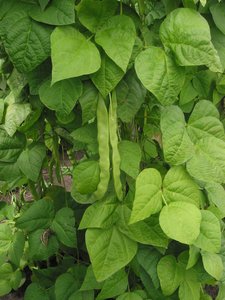
|
Common bean |
2-11
Annual
Full sun
Moist
Light (sandy), Medium, Heavy (clay)
2.0
Vines
Biomass, Dye, antifungal, Nitrogen fixer
true
Leaves, Seed, Seedpod
Seed - transplant, Seed - direct sow
https://en.wikipedia.org/wiki/Phaseolus_vulgaris
Pole bean, Climbing bean, French bean, Bush bean, Dwarf bean, Kidney bean, Green bean
Fabaceae, Leguminosae
Stangenbohne
https://pfaf.org/User/Plant.aspx?LatinName=Phaseolus vulgaris
16-18°c (70-80°f)
6.0-6.8
2.5 cm
16cm
4-10 days
45-85
Fast
Sperzieboon
Costa Rica, Guatemala, Honduras, Mexico Central, Mexico Gulf, Mexico Northeast, Mexico Northwest, Mexico Southeast, Mexico Southwest, Nicaragua, Panamá
Altay, Amur, Andaman Is., Angola, Argentina Northeast, Argentina Northwest, Assam, Baltic States, Bangladesh, Belarus, Bolivia, Bulgaria, Buryatiya, Cameroon, Cayman Is., Central European Rus, Chad, Chita, Colombia, Comoros, Cuba, Czechoslovakia, Dominican Republic, East European Russia, East Himalaya, Ecuador, Ethiopia, Guinea, Gulf of Guinea Is., Haiti, Illinois, India, Iraq, Irkutsk, Jamaica, Jawa, Kazakhstan, Kenya, Khabarovsk, Kirgizstan, Korea, Krasnoyarsk, Kuril Is., Leeward Is., Malaya, Marianas, Maryland, Mongolia, Myanmar, Nepal, New Guinea, New York, Nicobar Is., Nigeria, North Caucasus, North European Russi, Northwest European R, Pakistan, Peru, Philippines, Primorye, Puerto Rico, Queensland, Rwanda, Sakhalin, Senegal, South European Russi, Sri Lanka, Tadzhikistan, Tanzania, Thailand, Togo, Transcaucasus, Trinidad-Tobago, Turkmenistan, Tuva, Uganda, Ukraine, Uzbekistan, Venezuela, Vietnam, Wake I., West Himalaya, West Siberia, Yakutskiya, Zambia, Zaïre
2-4 weeks before last frost
1 week after last frost, 12-14 weeks before first frost
3-5 years
0.4
https://powo.science.kew.org/taxon/urn:lsid:ipni.org:names:514191-1
Coffee, Condiment
|
This entry describes all varieties of the common bean. This includes vining and bush/darf variaties and can have different names depending on their style of growths (see alternate names). These include the kidney bean, the navy bean, the pinto bean, the French bean and the wax bean The common bean, scientific name Phaseolus vulgaris, is a herbaceous annual plant native to the Americas, specifically the regions extending from the southwestern United States to South America. It is a member of the Fabaceae (legume) family. The common bean has a range of different appearances, depending on the variety. Most varieties have a simple, erect stem that grows to a height of 20-60 cm. The leaves are typically green and consist of 3-5 oblong leaflets. The flowers are small and white, pink, or purple in color. The fruit is a legume, which contains the seeds. The common bean is typically a small plant, but some varieties can grow to be quite large, reaching heights of up to 2 meters. The plant grows relatively quickly, with the growing season typically lasting between 60-100 days. The common bean prefers well-drained soil and full sun, but can also grow in partial shade. It is sensitive to frost and should be planted after the last frost date in the spring. To cultivate the common bean successfully, a grower may need to ensure that the soil is adequately fertilized and provide support for the plant to climb, if necessary. The common bean is edible, with the seeds and the young pods being the most commonly consumed parts. The seeds can be cooked and eaten as a protein-rich vegetable, and the young pods can be eaten as a green vegetable. The edible parts can be stored after harvest by drying the seeds or by preserving the young pods in vinegar or oil. The common bean has many uses beyond being a food source. The plant can fix nitrogen in the soil, improving its fertility and making it a useful companion plant for other crops. The dried leaves and stems of the common bean can be used as mulch or as a source of organic matter. In some cultures, the fibers from the stems are used to make ropes or other weaving materials. Additionally, the plant has been used medicinally to treat a variety of ailments. The common bean is also valuable for wildlife. The flowers attract bees and other pollinators, and the plant provides food for a variety of insects, birds, and small mammals. ### Links [Beans Seed Starting Tips @ Harvest to Table](https://harvesttotable.com/beans-seed-starting-tips/) ### Propagation - direct sow Direct-sow beans in spring after all danger of frost has passed and soil is at least 16°C (60°F). In warm-winter regions, sow beans in late summer for harvest in winter. Time sowing so that beans come to harvest before the first frost. |
Show
Edit |

|
Chives |
3-12
Full sun, Partial sun/shade
Moist
Light (sandy), Medium, Heavy (clay)
6.0-7.0
0.3
0.45
Perennial
Herbs
Medium
8-12inches
Seed - direct sow, Seed - transplant, Division
4-6 weeks before last frost
14-21 days
21°c (70°f)
antifungal, Dynamic accumulator, Ground cover, Fragrance
true
Flowers, Leaves, Root
Wild chives, Flowering onion
Schnittlauch
Alliaceae
Allium
Afghanistan, Alaska, Albania, Alberta, Altay, Austria, Baltic States, Belarus, British Columbia, Bulgaria, Buryatiya, Central European Rus, Chita, Colorado, Connecticut, Corse, Czechoslovakia, Denmark, East European Russia, Finland, France, Germany, Great Britain, Greece, Idaho, Iran, Iraq, Irkutsk, Italy, Japan, Kamchatka, Kazakhstan, Khabarovsk, Korea, Krasnoyarsk, Kuril Is., Labrador, Magadan, Maine, Manitoba, Massachusetts, Michigan, Minnesota, Mongolia, Montana, Netherlands, New Brunswick, New Hampshire, New Jersey, New York, North Caucasus, North European Russi, Northwest European R, Northwest Territorie, Norway, Nova Scotia, Nunavut, Ohio, Ontario, Oregon, Pakistan, Pennsylvania, Poland, Portugal, Primorye, Prince Edward I., Québec, Rhode I., Romania, Sakhalin, Saskatchewan, South European Russi, Spain, Sweden, Switzerland, Tadzhikistan, Transcaucasus, Turkey, Tuva, Ukraine, Vermont, Washington, West Himalaya, West Siberia, Wisconsin, Wyoming, Xinjiang, Yakutskiya, Yugoslavia, Yukon
Argentina South, Azores, Belgium, Comoros, Cuba, Dominican Republic, Falkland Is., Haiti, Illinois, Ireland, Jamaica, Maryland, Newfoundland, Seychelles, Trinidad-Tobago
https://en.wikipedia.org/wiki/Chives
https://pfaf.org/User/Plant.aspx?LatinName=Allium schoenoprasum
https://powo.science.kew.org/taxon/urn:lsid:ipni.org:names:528823-1
|
Chives (Allium schoenoprasum) are a bulb-forming herbaceous perennial plants that belong to the same family as onions, garlic, and leeks. They are native to Europe, Asia, and North America, and are commonly grown in gardens for their delicate onion flavor and attractive purple flowers. Chives are easy to grow and require little maintenance. They can be grown in pots or containers, or directly in the ground. The plants have thin, hollow leaves that grow in tight clumps and reach a height of around 12-20 inches (30-50 cm). The bulbs are slender, conical, 2–3 cm (3⁄4–1 1⁄4 in) long and 1 cm (1⁄2 in) broad, and grow in dense clusters from the roots. The scapes (or stems) are hollow and tubular, up to 50 cm (20 in) long and 2–3 mm (1⁄16–1⁄8 in) across, with a soft texture, although, prior to the emergence of a flower, they may appear stiffer than usual. The grass-like leaves, which are shorter than the scapes, are also hollow and tubular, or terete, (round in cross-section) which distinguishes it at a glance from garlic chives (Allium tuberosum). The flowers are pale purple, and star-shaped with six petals, 1–2 cm (1⁄2–3⁄4 in) wide, and produced in a dense inflorescence of 10-30 together; before opening, the inflorescence is surrounded by a papery bract. The seeds are produced in a small, three-valved capsule, maturing in summer. The herb flowers from April to May in the southern parts of its habitat zones and in June in the northern parts. Chives are often used as a seasoning in a variety of dishes, including soups, omelets, and dips. They can also be added to melted butter to make a simple but flavorful sauce for steamed vegetables. Chives are low in calories and a good source of vitamin C, making them a healthy addition to any diet. |
Show
Edit |

|
Coriandrum sativum |
2-11
Full sun, Partial sun/shade
Dry, Moist
Light (sandy), Medium
0.5
0.66
Annual
Herbs
5cm
5-10 days
15°C (60°F)
45-60
Essential Oil, Fire starter, antifungal, Pest control, oil, Fragrance
Leaves, Seed
Oil, Condiment
Cilantro, chinese parsley, dhania
Koriander
Apiaceae or Umbelliferae
Afghanistan, Iran, Lebanon-Syria, North Caucasus, Pakistan, Palestine, Saudi Arabia, Sinai, Transcaucasus, Turkey
Algeria, Amur, Andaman Is., Angola, Argentina Northeast, Argentina Northwest, Argentina South, Arizona, Assam, Austria, Azores, Baltic States, Bangladesh, Belarus, Belgium, Borneo, Brazil South, Bulgaria, California, Cambodia, Cameroon, Canary Is., Cape Provinces, Cape Verde, Central European Rus, Chad, China North-Central, China South-Central, China Southeast, Colombia, Connecticut, Costa Rica, Cuba, Cyprus, Czechoslovakia, Delaware, Denmark, Dominican Republic, East European Russia, East Himalaya, Ecuador, Egypt, El Salvador, Eritrea, Ethiopia, Fiji, Finland, Florida, France, Free State, Germany, Great Britain, Greece, Guatemala, Haiti, Hawaii, Hungary, Illinois, India, Iraq, Italy, Japan, Jawa, Juan Fernández Is., Kazakhstan, Kenya, Khabarovsk, Korea, Kriti, Krym, KwaZulu-Natal, Laos, Lesser Sunda Is., Libya, Louisiana, Madeira, Malaya, Maluku, Maryland, Massachusetts, Mauritius, Mexico Central, Mexico Northwest, Michigan, Missouri, Mongolia, Montana, Morocco, Mozambique, Nepal, Nevada, New Guinea, New Jersey, New Mexico, New York, New Zealand North, New Zealand South, Nicobar Is., Norfolk Is., North Carolina, North Dakota, Northern Provinces, Norway, Nova Scotia, Ohio, Oklahoma, Ontario, Oregon, Paraguay, Pennsylvania, Peru, Philippines, Poland, Portugal, Primorye, Puerto Rico, Québec, Rhode I., Rodrigues, Romania, Réunion, Sicilia, Somalia, South Carolina, South Dakota, South European Russi, Spain, Sri Lanka, Sudan, Sulawesi, Sumatera, Sweden, Switzerland, Tadzhikistan, Tanzania, Texas, Thailand, Trinidad-Tobago, Tunisia, Turkey-in-Europe, Turkmenistan, Uganda, Ukraine, Uzbekistan, Vietnam, Virginia, Washington, West Siberia, Yugoslavia, Zimbabwe
https://en.wikipedia.org/wiki/Coriander
https://pfaf.org/User/Plant.aspx?LatinName=Coriandrum sativum
https://powo.science.kew.org/taxon/urn:lsid:ipni.org:names:840760-1
true
|
Coriander, also known as cilantro or Chinese parsley, is a plant native to the Mediterranean region and western Asia. The plant has delicate, fern-like leaves and small, white or pale pink flowers. It grows to a height of about one to three feet, and matures fairly quickly, generally within three to four months. Coriander can be differentiated from similar plants by its distinctive, fragrant leaves and small, white or pale pink flowers. The plant prefers well-drained soil and full sun, and grows best when watered regularly. It is not winter hardy and should be grown as an annual in most regions. Coriander is often used as a culinary herb, and the leaves and seeds of the plant are both edible. The leaves have a distinctive, fragrant flavor and can be used fresh or dried in a variety of dishes. The seeds, which are often ground into a powder, have a warm, spicy flavor and are used in many curries and spice blends. In addition to its culinary uses, coriander has a number of other uses. The plant is said to have medicinal properties, and has been used in traditional medicine to treat a variety of ailments. It is also often used as a natural insect repellent, and some gardeners plant it near other crops to keep pests at bay. The plant is also valued by wildlife, and is a popular source of nectar for bees and other pollinators. ### Propagation - Direct sowing Direct sow in early spring after risk of frost. ### Propagation - Transplanting Avoid transplanting, as cilantro is quick to bolt under any stress. #### Links [Coriander @ West Coast Seeds](https://www.westcoastseeds.com/products/santo-organic) |
Show
Edit |
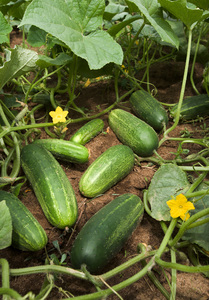
|
Cucumis sativus |
9-11
Annual
Full sun
Moist
Light (sandy), Medium, Heavy (clay)
2
Vines
Fruit, Leaves, Seed
Seed - direct sow, Seed - transplant
1 week after last frost
https://en.wikipedia.org/wiki/Cucumber
Cucurbitaceae
Gurke
50-65
23cm
6.0-6.8
15-30°C (60-85°F)
https://pfaf.org/User/Plant.aspx?LatinName=Cucumis sativus
True
Fruit
Assam, Bangladesh, China South-Central, China Southeast, East Himalaya, Myanmar, Nepal, Thailand, West Himalaya
Alabama, Albania, Andaman Is., Arizona, Arkansas, Austria, Bahamas, Bolivia, Caroline Is., Cayman Is., Colombia, Costa Rica, Cuba, Czechoslovakia, Denmark, Dominican Republic, Ecuador, Florida, Georgia, Gulf of Guinea Is., Haiti, Illinois, India, Jamaica, Kansas, Kazakhstan, Kentucky, Korea, Laos, Leeward Is., Louisiana, Marianas, Marshall Is., Massachusetts, Michigan, Mississippi, Missouri, New Caledonia, New York, Nicaragua, Nicobar Is., North Carolina, North Caucasus, Ohio, Oman, Ontario, Pakistan, Pennsylvania, Pitcairn Is., Puerto Rico, South Carolina, Sri Lanka, Sweden, Tadzhikistan, Trinidad-Tobago, Turkmenistan, Utah, Uzbekistan, Venezuela, Vietnam, Virginia, Windward Is., Zaïre
2-3 weeks before last frost
1 week after last frost
0.9
https://powo.science.kew.org/taxon/urn:lsid:ipni.org:names:292296-1
Oil
Cosmetic, oil
true
|
Cucumber, scientific name Cucumis sativus, is a member of the gourd family. It is native to India and other parts of Asia. Cucumber is a trailing or climbing plant that grows to a height of 5-10 feet. The leaves are dark green and glossy, and the plant produces yellow flowers. The fruit of the cucumber plant is a long, green, edible vegetable with a thin skin. Cucumbers are typically about 6-9 inches long and 2-3 inches in diameter. In terms of growth and cultivation, cucumber plants prefer warm, sunny conditions and well-draining soil. They should be watered regularly, especially during dry periods. Cucumber plants are not winter hardy and should be grown in the summer months in most climates. To cultivate cucumbers successfully, it is important to provide them with adequate space to grow and to support the plants with trellises or other means to keep the fruits off the ground. The plant will develop male and female flowers. You can recognize the female by having a tiny cucumber underneath. Sometimes the plant develops a lot of male flowers first, so be patient. If you don’t see any bees pollinating. Take a male and put it on all the female flowers. Cucumber fruits are edible and can be eaten raw, pickled, or cooked. The skin and seeds of the cucumber are edible, but some people choose to remove the seeds before eating the fruit. Cucumber fruits can be stored in the refrigerator for a few days after harvest. Cucumbers have several uses. In addition to being eaten as a vegetable, they can also be used in a variety of dishes and salads. Cucumber slices are often used as a garnish or as a refreshing addition to beverages. Cucumbers are also commonly used in natural skin care products and are believed to have anti-inflammatory and soothing properties. #### Propagation Direct sow when soil is warm enough in early summer. Sow seeds individually indoors 3-4 weeks before planting outside into warm soil. Use bottom heat if possible. Transplant when plants develop third leaf. #### Medicinal Fruit is depurative, diuretic, emollient, purgative and resolvent #### Links [Cucumber @ West Coast Seeds](https://www.westcoastseeds.com/products/patio-snacker) |
Show
Edit |

|
Apple |
3-8
Full sun, Partial sun/shade
Moist
Light (sandy), Medium, Heavy (clay)
Deciduous
10.0
9
Perennial
Trees
Animal feed, Attracts insects, Hedgerow
True
Fruit
Oil
Appel
Æble
Rosaceae
Malus
Afghanistan, Kazakhstan, Kirgizstan, Pakistan, Tadzhikistan, Uzbekistan, Xinjiang
Alabama, Alaska, Albania, Argentina Northeast, Argentina South, Arkansas, Azores, Baleares, Baltic States, Belarus, Belgium, British Columbia, Bulgaria, California, Central European Rus, Colorado, Connecticut, Cyprus, Czechoslovakia, Delaware, Denmark, District of Columbia, East European Russia, East Himalaya, Ecuador, Falkland Is., Finland, France, Georgia, Germany, Great Britain, Greece, Hungary, Illinois, Indiana, Iowa, Iraq, Ireland, Italy, Kansas, Kentucky, Korea, Krym, Louisiana, Madeira, Maine, Manitoba, Maryland, Massachusetts, Michigan, Minnesota, Mississippi, Missouri, Montana, Nebraska, Nepal, Netherlands, Nevada, New Brunswick, New Hampshire, New Jersey, New Mexico, New South Wales, New York, Newfoundland, North Carolina, North Caucasus, North Dakota, Norway, Nova Scotia, Ohio, Ontario, Oregon, Pennsylvania, Poland, Prince Edward I., Québec, Rhode I., Romania, South Carolina, South European Russi, Spain, Sweden, Tasmania, Tennessee, Turkmenistan, Ukraine, Utah, Vermont, Victoria, Virginia, West Virginia, Wisconsin, Wyoming, Yugoslavia
https://en.wikipedia.org/wiki/Apple
https://pfaf.org/user/plant.aspx?LatinName=Malus+domestica
https://powo.science.kew.org/taxon/urn:lsid:ipni.org:names:726282-1
Apfel
|
An apple is an edible fruit produced by an apple tree (Malus domestica). Apple trees are cultivated worldwide and are the most widely grown species in the genus Malus. The tree originated in Central Asia, where its wild ancestor, Malus sieversii, is still found today. Apples have been grown for thousands of years in Asia and Europe and were brought to North America by European colonists. Apples have religious and mythological significance in many cultures, including Norse, Greek, and European Christian tradition. Apples grown from seed tend to be very different from those of their parents, and the resultant fruit frequently lacks desired characteristics. Generally, apple cultivars are propagated by clonal grafting onto rootstocks. Apple trees grown without rootstocks tend to be larger and much slower to fruit after planting. Rootstocks are used to control the speed of growth and the size of the resulting tree, allowing for easier harvesting. There are more than 7,500 known cultivars of apples. Different cultivars are bred for various tastes and uses, including cooking, eating raw, and cider production. Trees and fruit are prone to a number of fungal, bacterial, and pest problems, which can be controlled by a number of organic and non-organic means. In 2010, the fruit's genome was sequenced as part of research on disease control and selective breeding in apple production. Worldwide production of apples in 2018 was 86 million tonnes, with China accounting for nearly half of the total. From [Wikipedia](https://en.wikipedia.org/wiki/Apple) |
Show
Edit |
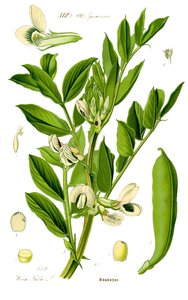
|
Broad Bean |
4-8
Full sun, Partial sun/shade
Moist
Light (sandy), Medium, Heavy (clay)
6.0-6.8
1.0
0.3
Annual
Fast
20cm
Seed - direct sow, Seed - transplant
6 weeks after sowing them in pots
6 weeks after sowing them in pots
21 days
3-5 years
Nitrogen fixer
Leaves, Seed
fava bean, faba bean, Broad bean, or faba bean Varieties with smaller, harder seeds that are fed to horses or other animals are called field bean, tic bean or tick bean Horse bean
Ackerbohne
Fabaceae or Leguminosae
Afghanistan, Iran
Albania, Algeria, Altay, Angola, Argentina South, Assam, Baleares, Bangladesh, Bolivia, Bulgaria, Cameroon, Canary Is., Central European Rus, Chad, China North-Central, China South-Central, China Southeast, Colombia, Corse, Cuba, Cyprus, Czechoslovakia, Dominican Republic, East Aegean Is., East European Russia, Ecuador, Ethiopia, France, Guatemala, India, Iraq, Italy, Jawa, Kenya, Krym, Lebanon-Syria, Leeward Is., Libya, Madeira, Mexico Southwest, Mongolia, Morocco, Myanmar, Nepal, New South Wales, New York, New Zealand North, New Zealand South, Pakistan, Peru, Portugal, Puerto Rico, Rwanda, Sardegna, Sicilia, Spain, Sri Lanka, Sudan, Tibet, Tunisia, Turkey, Turkey-in-Europe, Uruguay, Vermont, Vietnam, West Himalaya, Yemen, Yugoslavia
https://en.wikipedia.org/wiki/Vicia_faba
https://pfaf.org/User/Plant.aspx?LatinName=Vicia faba major
https://powo.science.kew.org/taxon/urn:lsid:ipni.org:names:524737-1
Feb-April; Oct-Nov
sow in deep pots in cool, frost-free place
|
Broad bean (Vicia faba), also known as fava bean or faba bean, is a type of legume that is native to North Africa and the Middle East. It is a popular garden plant, known for its edible beans and attractive purple or white flowers. Broad bean plants have a upright, bushy growth habit and can reach a height of up to 3 feet. The leaves are large and composed of three oval-shaped leaflets, and the flowers are small and clustered in groups of two or three. The beans are produced in long, slender pods that contain two or three beans each. To grow broad beans successfully, it is important to choose a location with well-drained, fertile soil and full sun. The plants should be spaced about 8-12 inches apart, and watered regularly to ensure that the soil stays moist but not waterlogged. Broad beans are generally easy to grow and require little maintenance, but they can be susceptible to pests and diseases, such as aphids and fungal infections. Grows best in temperatures ranging from 60° to 65°F (15-18°C) but will tolerate a range from 40°F (4.4°C) - 75°F (24°C). Broad beans are edible, and the beans can be eaten fresh or frozen, canned or dried for storage. To harvest the beans, the pods should be picked when they are plump and before the beans inside begin to harden. The beans can be removed from the pods by gently squeezing them out. Fresh beans can be stored in the refrigerator for a few days, while dried beans can be stored in an airtight container for several months. In addition to their culinary uses, broad beans also have a number of medicinal properties, and have been used to treat a variety of ailments, including asthma, bronchitis, and anemia. Broad beans are also a valuable food source for many types of wildlife, including birds, insects, and small mammals. The plants provide nectar for bees and other pollinators, and the beans are a popular food for many species of birds. |
Show
Edit |
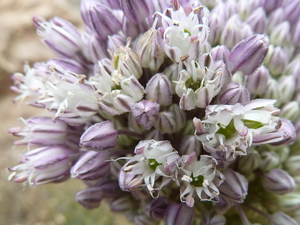
|
Allium ampeloprasum |
5-9
Full sun
Dry, Moist
Light (sandy), Medium, Heavy (clay)
1.8
0.3
Herbs
true
Flowers, Leaves, Root
Broadleaf wild leek
Lauch
Alliaceae
Albania, Algeria, Baleares, Bulgaria, Cyprus, East Aegean Is., Egypt, Ethiopia, France, Greece, Iran, Iraq, Italy, Kriti, Lebanon-Syria, Libya, Morocco, Palestine, Portugal, Romania, Sardegna, Sicilia, Sinai, Spain, Transcaucasus, Tunisia, Turkey, Turkey-in-Europe, Turkmenistan, Uzbekistan, Yugoslavia
Alabama, Argentina Northeast, Azores, Baltic States, Belarus, California, Canary Is., Central European Rus, Cuba, Czechoslovakia, Dominican Republic, East European Russia, Galápagos, Great Britain, Haiti, Illinois, Ireland, Kentucky, Madeira, Mexico Central, Mexico Northeast, Mexico Northwest, Mexico Southeast, Mexico Southwest, New South Wales, New York, North European Russi, Northwest European R, Pakistan, Puerto Rico, South Australia, South European Russi, Tasmania, Tennessee, Texas, Ukraine, Victoria, Western Australia
https://en.wikipedia.org/wiki/Allium_ampeloprasum
https://pfaf.org/User/Plant.aspx?LatinName=Allium ampeloprasum
https://powo.science.kew.org/taxon/urn:lsid:ipni.org:names:332079-2
|
Show
Edit |
|

|
Nectarine |
4-8
Perennial
Full sun
Moist
Light (sandy), Medium, Heavy (clay)
Deciduous
6.0
Trees
Adhesive, Cleanser, Dye, Gum, oil, Espalier
true
Flowers, Fruit, Seed
Rosaceae
Nektarine
Oil, Gum, Tea
https://pfaf.org/User/Plant.aspx?LatinName=Prunus persica nucipersica
Nectarine
Nektarin
3
|
Nectarine (Prunus persica nucipersica) is a plant that is a type of stone fruit. It is native to China and is closely related to the peach. Nectarines are similar in appearance to peaches, but have smooth skin rather than fuzzy skin. They can range in size from small to large and are typically round or oval in shape. Nectarines have green or red leaves and white or pink flowers. The stems of the plant are generally thin and have thorns. Nectarines can grow to be quite large, reaching heights of up to 8 meters. They grow best in warm, sunny climates and well-drained soil. To cultivate nectarines successfully, a grower will need to provide the plant with plenty of sunlight and water. They may also need to prune the plant to maintain its shape and encourage new growth. Nectarines are edible and the fruit can be eaten fresh or cooked. The edible parts of the fruit can be stored in a cool, dry place after harvest. Nectarines have several uses. In addition to being eaten fresh or cooked, they can also be used to make jams, jellies, and other preserves. They can also be dried and used as a snack. In addition to their culinary uses, nectarines have been used medicinally for their high vitamin and mineral content. They are also valued for their ability to attract wildlife, such as birds and bees, to the garden. |
Show
Edit |

|
Sweet cherry |
3-7
Perennial
Full sun, Partial sun/shade
Moist
Light (sandy), Medium, Heavy (clay)
Deciduous
18.0
Trees
Dye, Gum, Tannin, Lumber, Espalier
true
Fruit, Seed
https://en.wikipedia.org/wiki/Prunus_avium
Fast
Sweet cherry
Rosaceae
Süßkirsche
https://pfaf.org/User/Plant.aspx?LatinName=Prunus avium
183
Afghanistan, Albania, Algeria, Austria, Belarus, Belgium, Bulgaria, Corse, Cyprus, Czechoslovakia, Denmark, France, Germany, Great Britain, Greece, Hungary, Iran, Ireland, Italy, Krym, Libya, Morocco, Netherlands, North Caucasus, Norway, Poland, Portugal, Romania, Sardegna, Sicilia, Spain, Sweden, Switzerland, Transcaucasus, Tunisia, Turkey, Turkey-in-Europe, Ukraine, Yugoslavia
Arizona, Baleares, Baltic States, British Columbia, California, Central European Rus, Connecticut, Delaware, District of Columbia, East European Russia, East Himalaya, Finland, Idaho, Illinois, Indiana, Kazakhstan, Kentucky, Korea, Maine, Maryland, Massachusetts, Michigan, New Brunswick, New Hampshire, New Jersey, New Mexico, New South Wales, New York, New Zealand North, New Zealand South, North Carolina, Nova Scotia, Ohio, Ontario, Oregon, Pakistan, Pennsylvania, Rhode I., South Australia, South Carolina, South European Russi, Tadzhikistan, Tennessee, Turkmenistan, Utah, Victoria, Virginia, Washington, West Himalaya, West Virginia, Wyoming
3
https://powo.science.kew.org/taxon/urn:lsid:ipni.org:names:30093848-2
Gum
|
The sweet cherry, Prunus avium, is a fruit-bearing tree that is native to Europe, western Asia, and northern Africa. It typically grows to a height of 15-30 feet, with a spread of 20-25 feet, and has a rounded crown. The leaves are oblong-shaped, with serrated edges and a glossy dark green color. The flowers are white or pale pink, with five petals, and appear in clusters in the spring before the leaves. The fruit, which is the sweet cherry, is a small, round drupe, with a smooth, dark red or black skin and a juicy, sweet flesh. In terms of growing conditions, the sweet cherry prefers well-drained, fertile soil and full sun exposure. It can be grown in a variety of climates, but may require protection from frost in harsh climates. To cultivate the sweet cherry successfully, a grower may need to prune the tree to maintain its shape, provide adequate water and fertilizer, and protect the tree from pests and diseases. The sweet cherry is edible and can be eaten fresh or used in a variety of culinary dishes. The fruit can be stored in the refrigerator for a few days or preserved by freezing or canning. The sweet cherry is also valued for its medicinal properties, as the fruit and leaves have been used in traditional medicine to treat a variety of ailments. In terms of its value for wildlife, the sweet cherry provides food for a variety of animals, including birds, squirrels, and other small mammals. It also provides shelter and habitat for these animals. |
Show
Edit |

|
Asparagus |
2-9
Full sun, Partial sun/shade
Moist
Light (sandy), Medium, Heavy (clay)
6.5-7.0
Evergreen
1-1.5m
1
Perennial
Herbs
Slow
12-18 inches rows, 6–8inches in row
Seed - direct sow, Seed - transplant, Division
16 weeks before last frost date
10-12 weeks, 1 week after last frost date
2-8 weeks
21-29°c (70-85°f)
true
Shoots, Stem
Sparrow grass
Spargel
Asparagaceae
Europe, Western asia, Afghanistan, Albania, Altay, Austria, Belarus, Bulgaria, Central European Rus, Corse, Czechoslovakia, France, Germany, Greece, Hungary, Iran, Kazakhstan, Krasnoyarsk, Krym, Lebanon-Syria, Mongolia, North Caucasus, Pakistan, Poland, Sicilia, South European Russi, Switzerland, Transcaucasus, Turkey, Turkey-in-Europe, Ukraine, West Siberia, Xinjiang
Alabama, Alberta, Algeria, Argentina Northeast, Argentina Northwest, Argentina South, Arizona, Arkansas, Baltic States, Bangladesh, Belgium, Bolivia, British Columbia, California, Colorado, Connecticut, Costa Rica, Cyprus, Delaware, Denmark, District of Columbia, East European Russia, East Himalaya, Ethiopia, Finland, Florida, Georgia, Great Britain, Idaho, Illinois, Indiana, Iowa, Ireland, Kansas, Kentucky, Labrador, Louisiana, Madagascar, Maine, Manitoba, Marianas, Maryland, Massachusetts, Mauritius, Mexico Central, Mexico Gulf, Mexico Northeast, Mexico Southeast, Mexico Southwest, Michigan, Minnesota, Mississippi, Missouri, Montana, Morocco, Nebraska, Netherlands, Nevada, New Brunswick, New Hampshire, New Jersey, New Mexico, New South Wales, New York, New Zealand North, New Zealand South, Newfoundland, North Carolina, North Dakota, North European Russi, Northwest European R, Norway, Nova Scotia, Ohio, Oklahoma, Ontario, Oregon, Pennsylvania, Portugal, Prince Edward I., Queensland, Québec, Rhode I., Réunion, Sardegna, Saskatchewan, Seychelles, Solomon Is., South Australia, South Carolina, South Dakota, Spain, Sweden, Tasmania, Tennessee, Texas, Trinidad-Tobago, Tunisia, Uruguay, Utah, Vermont, Victoria, Virginia, Washington, West Himalaya, West Virginia, Western Australia, Wisconsin, Wyoming
True
https://en.wikipedia.org/wiki/asparagus
https://pfaf.org/user/plant.aspx?latinname=asparagus officinalis
https://powo.science.kew.org/taxon/urn:lsid:ipni.org:names:531229-1
Fasciculated
3-8inches
8-12 weeks before last frost
Toxic fruits
Coffee
Pest control
|
Asparagus officinalis is a plant native to most of Europe, northern Africa, and western Asia. It is a herbaceous perennial plant that typically grows to around 0.5 to 1.5 meters in height, with slender stems and feathery leaves. The stems are typically green, but some varieties can have purple or white stems. The plant produces small, fragrant white or pink flowers in the spring, which give way to red berries in the fall, which are toxic to humans. Asparagus is a fast-growing plant that prefers well-draining, fertile soil and full sun exposure. It can grow in saline soils where other plants to do not grow. A soil pH below 6 is possible but best is to adjust to 6.5-7.0. It can be grown from seed or from crowns, and typically takes 2-3 years to reach maturity and begin producing edible shoots, which can be harvested for around 8-12 weeks each season. In cold climates, asparagus is winter hardy and can be left in the ground to overwinter. In warmer climates, it may need to be dug up and stored in a cool, dry place during the winter months. The edible shoots of asparagus can be harvested in the spring and early summer. They can be eaten raw or cooked, and have a delicate, slightly sweet flavor. The shoots can be stored in the refrigerator for a few days, but are best used fresh. Asparagus is a low-calorie, nutrient-dense vegetable, with high levels of vitamins A, C, and K, as well as folate and fiber. In addition to its use as a food, asparagus has a number of other uses. It is often used medicinally to treat a variety of conditions, including digestive disorders and urinary tract infections. The plant's leaves and stems can be used as mulch or compost, and the roots can help to fix nitrogen in the soil, making it useful for improving soil health. Asparagus has also been used as a weaving material and as a building material, due to its strength and durability. Asparagus is a valuable plant for wildlife, providing food and habitat for a variety of animals. The plant's flowers attract bees and other pollinators, and the berries are eaten by birds and small mammals. Asparagus is a good companion plant to the Tomato since it repels some harmful root nematodes for Tomatoes and Tomatoes repel the asparagus beetle. |
Show
Edit |
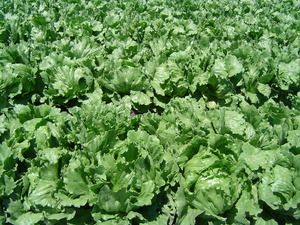
|
Lactuca sativa |
5-9
Annual, Biennial
Full sun, Partial sun/shade
Moist
Light (sandy), Medium
0.9
Herbs
true
Leaves, Seed
https://en.wikipedia.org/wiki/Lettuce
Garden lettuce
Asteraceae or compositae
Blattsalat
Oil
https://pfaf.org/User/Plant.aspx?LatinName=Lactuca sativa
Iraq
Alabama, Antipodean Is., Argentina Northeast, Assam, Austria, Baleares, Baltic States, Bangladesh, Belize, Bolivia, Bulgaria, Burkina, California, Cameroon, Canary Is., Cape Provinces, Cape Verde, Caroline Is., Central European Rus, Chad, China North-Central, Colombia, Connecticut, Corse, Costa Rica, Cuba, Cyprus, Czechoslovakia, Delaware, District of Columbia, Dominican Republic, East European Russia, East Himalaya, Ecuador, Egypt, El Salvador, Fiji, Finland, France, Free State, Germany, Great Britain, Guatemala, Haiti, Hawaii, Honduras, Hungary, Idaho, Illinois, Indiana, Inner Mongolia, Ireland, Italy, Jamaica, Jawa, Kazakhstan, Khabarovsk, Korea, Krym, Lebanon-Syria, Madeira, Maine, Marianas, Marshall Is., Massachusetts, Mauritania, Mauritius, Mexico Southeast, Michigan, Missouri, Myanmar, Nepal, Netherlands, New Guinea, New Hampshire, New Jersey, New Mexico, New York, Nicaragua, Niue, North Carolina, North Caucasus, North Dakota, North European Russi, Northwest European R, Ohio, Oklahoma, Oman, Ontario, Oregon, Pakistan, Panamá, Paraguay, Pennsylvania, Peru, Philippines, Poland, Portugal, Primorye, Puerto Rico, Rhode I., Romania, Réunion, Sardegna, Sicilia, South European Russi, Spain, Sweden, Switzerland, Taiwan, Transcaucasus, Trinidad-Tobago, Tubuai Is., Turkey, Turkey-in-Europe, Ukraine, Uzbekistan, Venezuela, Vermont, Vietnam, Wake I., Washington, West Virginia, Yugoslavia
30cm
https://powo.science.kew.org/taxon/urn:lsid:ipni.org:names:228239-1
Hair, oil, Pest control
|
Lettuce, Lactuca sativa, is a plant native to the Mediterranean region. It has green, elongated leaves that form a loose head. The stem is relatively short and the plant grows to a height of about 8-12 inches. Lettuce is a fast-growing plant, with some varieties able to be harvested in as little as 45 days. Lettuce can be differentiated from similar plants by its elongated leaves and loose head formation. It is also relatively short compared to other leafy green plants like kale and spinach. Lettuce prefers cool temperatures and grows best in full sun or partial shade. It is a hardy plant and can tolerate light frost, but will not survive extreme cold. To cultivate lettuce successfully, growers should ensure that the soil is well-drained and moist, and that the plants are spaced appropriately. Lettuce is edible and the leaves can be eaten raw in salads or cooked. The leaves can also be stored by washing and drying them, and then wrapping them in a damp paper towel before placing them in the refrigerator. Lettuce has a number of uses. It is a popular ingredient in salads and other dishes, and has been used medicinally to treat a variety of ailments, including insomnia and digestive issues. |
Show
Edit |

|
Marjoram |
6-9
Perennial
Full sun, Partial sun/shade
Dry, Moist
Light (sandy), Medium, Heavy (clay)
0.6
Herbs
true
Leaves
https://en.wikipedia.org/wiki/Marjoram
Lamiaceae or labiatae
Majoran
https://pfaf.org/User/Plant.aspx?LatinName=Origanum majorana
Cyprus, Turkey
Algeria, Azores, Baleares, Baltic States, Corse, Czechoslovakia, Great Britain, Greece, India, Italy, Juan Fernández Is., Krym, Libya, Madeira, Morocco, Spain, Switzerland, Tunisia, Ukraine, Venezuela, Yugoslavia
https://powo.science.kew.org/taxon/urn:lsid:ipni.org:names:453303-1
Condiment, Tea
Disinfectant, Dye, Essential Oil, Fragrance
|
Marjoram (Origanum majorana) is a herbaceous plant that is native to the Mediterranean region. It has delicate, oval-shaped leaves that are pale green in color, and small white or pink flowers that grow in clusters. The plant grows to a height of about 30 cm and has a woody stem. In terms of growing conditions, marjoram prefers well-drained, light soil and full sun to partial shade. It can be grown from seeds or cuttings, and should be spaced about 30 cm apart. Marjoram is winter hardy in mild climates, but may need to be protected or brought indoors in colder regions. Marjoram has a number of culinary uses. It is often used as a flavoring in soups, stews, and sauces, and can be added to salads and other dishes as a garnish. The leaves and flowers of the plant are edible and can be used fresh or dried. When harvesting marjoram, it is best to pick the leaves early in the morning when they are at their most flavorful. The leaves can be stored in an airtight container in a cool, dark place for up to six months. In addition to its culinary uses, marjoram has also been used medicinally as an antiseptic and as a remedy for digestive problems. It is also sometimes used in perfumes and soaps. Marjoram is not particularly attractive to wildlife, but it can provide habitat for some beneficial insects such as bees and butterflies. |
Show
Edit |

|
Allium cepa |
3-9
Annual
Full sun
Moist
Light (sandy), Medium
0.6
Herbs
Flowers, Leaves, Root, Seed
Seed - direct sow, Seed - transplant
https://en.wikipedia.org/wiki/Onion
Garden onion
Alliaceae
Zwiebel
https://pfaf.org/User/Plant.aspx?LatinName=Allium cepa
50°f, 10°c
Seed indoors 6 weeks before transplanting in the garden
2-6 inches
6.0-7.0
Allium
Turkmenistan
Algeria, Argentina Northeast, Arkansas, Baltic States, Bangladesh, Belarus, Bulgaria, California, Cambodia, Canary Is., Central European Rus, China North-Central, China South-Central, China Southeast, Colombia, Cuba, Czechoslovakia, Dominican Republic, East Aegean Is., East European Russia, East Himalaya, Ecuador, Egypt, Ethiopia, Fiji, France, Galápagos, Guinea-Bissau, Haiti, Illinois, India, Iraq, Italy, Jamaica, Kansas, Kentucky, Kirgizstan, Korea, Krym, Libya, Louisiana, Madeira, Manchuria, Mauritania, Mexico Central, Mexico Gulf, Mexico Northeast, Mexico Southeast, Mexico Southwest, Minnesota, Montana, Morocco, New York, Niue, North European Russi, Northwest European R, Oregon, Pakistan, Puerto Rico, Seychelles, South European Russi, Spain, Tadzhikistan, Texas, Thailand, Tibet, Tonga, Trinidad-Tobago, Ukraine, Uzbekistan, Vermont, Washington, West Himalaya, West Siberia, Wisconsin, Xinjiang, Yugoslavia
Spring or fall
0.3
https://powo.science.kew.org/taxon/urn:lsid:ipni.org:names:527795-1
Cosmetic, Dye, Hair, Polish, Rust
true
|
Onion (Allium cepa) is a plant species in the family Amaryllidaceae. It is native to central Asia and is commonly grown as a vegetable in many parts of the world. Onions are biennial plants, meaning they typically have a two-year life cycle. In the first year, the onion forms a small, rounded bulb with thin, papery skin. In the second year, the onion will produce a tall stem with hollow, elongated leaves and a small, spherical flower head. Onions are typically grown for their bulbs, which are used as a food ingredient in many dishes. The bulbs can vary in size and shape, depending on the variety, but are generally spherical or oblong in shape and range in size from about 2-4 inches in diameter. Onions are commonly differentiated by their color, which can range from white to yellow to red. Onions prefer well-drained soil that is rich in organic matter. They should be planted in a sunny location and will benefit from regular watering, especially during dry periods. Onion bulbs can be harvested when they reach the desired size, typically after about 100-150 days of growth. To store onions, they should be dried and cured in a cool, dry place for about two weeks before being placed in a mesh bag or other breathable container. Onions are edible and are commonly used as a food ingredient in many dishes. The bulbs are the most commonly used part of the plant, but the leaves and stems can also be used in cooking. Onions have a pungent, spicy flavor and are often used to add flavor to soups, stews, and other dishes. Onions can be stored for several months if properly dried and cured. In addition to their use as a food ingredient, onions have also been used for their medicinal properties. They have been used to treat a variety of ailments, including coughs, colds, and respiratory infections. Onions are also sometimes used as a natural fertilizer, due to the high levels of sulfur and other nutrients they contain. Onions are not known to provide significant value to wildlife. They are not a preferred food source for most animals and do not provide any significant habitat value. However, some insects, such as the onion maggot, can be pests of onion crops. |
Show
Edit |
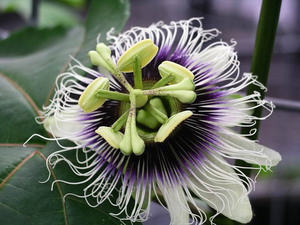
|
Passiflora edulis |
https://en.wikipedia.org/wiki/Passiflora_edulis
true
Fast
Moist
Full sun
9-12
Vines
Purple granadilla, passion fruit, granadilla, aul aanp, bai xiang guo, buah negeri, buah susu, garendal, granadiglia, granadilho, grenadille, ji dan guo, kudamonotokeiso, liliko'i, linmangkon, louki, magalendendele, maracuja-roxo, maracuya, markisa, maseche, matunda, munchi, obutunda, pasionaria, purpurgrenadille, qaranidila, sawarot, soh-brap, tikeiso, common passionfruit, fleur de la passion, flor de la pasión, granadiglia incarnata, granadilla, grenadella, kalala, maracayú, maracujá, maracujá azedo, maracujá-comum, maracujá-de-comer, maracujá-de-ponche, maracujá-do-mato, maracujá-doce, maracujá-mirim, maracujá-peroba, maracujá-preto, maracujá-redondo, maracuya, pasiflora, passiflora, passiflorae acetum folium, passiflore, passion flower, passion fruit, passion fruit|wel dodam, passionsblume, passionsfrukt, purple granadilla, purple passionflower
Light (sandy), Medium, Heavy (clay)
Passifloraceae
9.0
Oil, Drink, Sweetener
Weed potential
Fruit
Perennial
https://pfaf.org/User/Plant.aspx?LatinName=Passiflora edulis
Argentina Northeast, Brazil Northeast, Brazil South, Brazil Southeast, Brazil West-Central, Paraguay
Angola, Argentina Northwest, Assam, Azores, Bangladesh, Benin, Bolivia, Borneo, Brazil North, Burundi, Cambodia, Cameroon, Canary Is., Caroline Is., Central African Repu, China South-Central, China Southeast, Colombia, Comoros, Cook Is., Costa Rica, Cuba, Dominican Republic, East Himalaya, El Salvador, Ethiopia, Fiji, Florida, Gabon, Galápagos, Gambia, Gilbert Is., Guatemala, Gulf of Guinea Is., Hawaii, Honduras, India, Jamaica, Jawa, Kenya, KwaZulu-Natal, Laos, Leeward Is., Lesser Sunda Is., Malawi, Malaya, Marianas, Marshall Is., Mauritius, Mexico Central, Mexico Northeast, Mexico Southeast, Mexico Southwest, Morocco, Mozambique, New Caledonia, New South Wales, New Zealand North, Norfolk Is., Northern Provinces, Panamá, Peru, Puerto Rico, Queensland, Rodrigues, Réunion, Sri Lanka, Sudan, Swaziland, Taiwan, Tanzania, Thailand, Tonga, Trinidad-Tobago, Uganda, Venezuela, Victoria, Vietnam, West Himalaya, Windward Is., Zambia, Zaïre, Zimbabwe
https://powo.science.kew.org/taxon/urn:lsid:ipni.org:names:321964-2
Fencing, oil, Fragrance
|
Show
Edit |
|
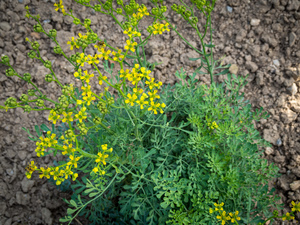
|
Ruta graveolens |
4-10
Full sun, Partial sun/shade
Dry, Moist
Light (sandy), Medium, Heavy (clay)
0.5
Shrubs
true
Leaves
https://en.wikipedia.org/wiki/Ruta_graveolens
Medium
Common rue, herb of grace, garden rue
Rutaceae
Weinraute
https://pfaf.org/User/Plant.aspx?LatinName=Ruta graveolens
Albania, Bulgaria, Krym, Turkey-in-Europe, Yugoslavia
Alberta, Algeria, Austria, Baleares, Belgium, California, Canary Is., Cape Provinces, Connecticut, Corse, Czechoslovakia, District of Columbia, East Aegean Is., Ecuador, France, Germany, Great Britain, Greece, Hungary, Illinois, Italy, Missouri, New Jersey, New York, North Carolina, Northern Provinces, Ontario, Pennsylvania, Québec, Rhode I., Romania, South European Russi, Spain, Switzerland, Texas, Ukraine, Vermont, Vietnam, Virginia, West Virginia, Wisconsin
https://powo.science.kew.org/taxon/urn:lsid:ipni.org:names:775099-1
Condiment, Rutin, Tea
Dye, Essential Oil, Strewing, Ground cover, Fragrance
|
Rue (Ruta graveolens) is a perennial herb native to the Balkan Peninsula. It is a small plant, growing to a height of about 30-60 cm (12-24 inches), with blue-green leaves and small, yellow flowers. The leaves have a strong, pungent aroma, and the plant is often used as a natural insect repellent. In terms of growing conditions, Rue prefers well-drained soil and full sun. It is drought-resistant and can be grown in a variety of climates, though it may not do well in extremely hot or humid conditions. To cultivate Rue successfully, a grower should plant it in a location that receives plenty of sunlight, and ensure that the soil is well-drained. Rue is not generally considered to be edible, and can cause skin irritation and other negative effects if ingested. However, it has been used medicinally in the past, and is sometimes used as a natural insect repellent or as a source of blue dye. It is also sometimes used in traditional witchcraft. In terms of its value to wildlife, Rue is a good source of nectar for bees and other pollinators, and its strong aroma may help to repel pests from nearby plants. It is not known to have any significant value as a food source for animals. |
Show
Edit |

|
Peach |
5-9
Perennial
Full sun
Moist
Light (sandy), Medium, Heavy (clay)
6
Trees
true
Flowers, Fruit, Seed
https://en.wikipedia.org/wiki/Peach
Fast
Flowering peach, ornamental peach, common peach
Rosaceae
Pfirsich, bergpfirsich, tellerpfirsich, saturnpfirsich, weinbergpfirsich
Oil, Gum, Tea
https://pfaf.org/User/Plant.aspx?LatinName=Prunus persica
China North-Central
Afghanistan, Alabama, Argentina Northwest, Arizona, Arkansas, Assam, Baleares, Bulgaria, California, Cape Verde, China South-Central, China Southeast, Colorado, Connecticut, Corse, Cyprus, Delaware, District of Columbia, East European Russia, East Himalaya, Ecuador, El Salvador, Ethiopia, Florida, France, Free State, Georgia, Greece, Hungary, Idaho, Illinois, India, Indiana, Iowa, Iran, Italy, Japan, Kansas, Kazakhstan, Kentucky, Kenya, Kirgizstan, Korea, Kriti, Krym, KwaZulu-Natal, Laos, Libya, Louisiana, Maine, Marianas, Maryland, Massachusetts, Mauritius, Michigan, Mississippi, Missouri, New Jersey, New Mexico, New South Wales, New York, New Zealand North, North Carolina, North Caucasus, Northern Provinces, Nova Scotia, Ohio, Oklahoma, Ontario, Oregon, Pakistan, Pennsylvania, Portugal, Queensland, Rhode I., Rodrigues, Romania, Réunion, Sardegna, South Australia, South Carolina, South European Russi, St.Helena, Switzerland, Tadzhikistan, Tennessee, Texas, Transcaucasus, Turkey, Turkmenistan, Ukraine, Utah, Uzbekistan, Vietnam, Virginia, West Himalaya, West Virginia, Wisconsin
3
https://powo.science.kew.org/taxon/urn:lsid:ipni.org:names:1212858-2
Adhesive, Cleanser, Dye, Gum, oil, Espalier
|
The peach, scientifically known as Prunus persica, is a deciduous tree native to northwest China. It typically grows to be about 10-30 feet tall, with a short trunk and a rounded crown. The leaves are oval-shaped, with serrated edges and a glossy, dark green color. The flowers are pink and white, with five petals each. Peaches are known for their fuzzy, peach-colored skin and juicy, sweet flesh. They can be eaten fresh, canned, or cooked into dishes such as pies and cobblers. The edible parts of the peach include the flesh and the seed, which contains a small kernel that can be ground into flour. Peaches can be stored after harvest by keeping them in a cool, dry place. Peaches prefer well-draining, loamy soil and full sun. They can be grown in a variety of climates, but do best in warm, temperate regions. To cultivate peaches successfully, growers may need to provide support for the trees, prune them regularly, and protect them from pests and diseases. Peaches are generally winter hardy, but can be damaged by frost. In addition to being eaten fresh, peaches have a variety of uses. The flowers can be used in herbal teas, and the leaves can be used to make a yellow dye. The wood of the tree can be used for smoking meat, and the kernels can be used to make oil. Peaches are also a valuable food source for wildlife, attracting birds, squirrels, and other animals. |
Show
Edit |
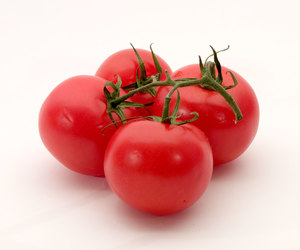
|
Tomato |
10-12
Annual, Perennial
Full sun
Moist
Light (sandy), Medium, Heavy (clay)
2.0
True
Fruit, Seed
https://en.wikipedia.org/wiki/Tomato
Fast
Garden tomato, Dumádu, Garden tomato, Love apple, Lycopersicum esculentum, Tomate, Tomato, Tomato extract containing lycopene, Tomato|thakkali, Tumatis, Lycopersicon esculentum
Solanaceae
Tomate
Oil
https://pfaf.org/User/Plant.aspx?LatinName=Solanum lycopersicum, https://pfaf.org/User/Plant.aspx?LatinName=Lycopersicon esculentum
Start seeds indoors 5-6 weeks before last frost
In containers or in rows in beds around last frost date
6.2-6.8
70-80°f
Peru
Alabama, Alaska, Andaman Is., Angola, Arizona, Arkansas, Assam, Austria, Azores, Bahamas, Bangladesh, Belarus, Benin, Bolivia, British Columbia, Bulgaria, Burkina, California, Cambodia, Cameroon, Canary Is., Cape Verde, Caroline Is., Central African Repu, Chagos Archipelago, Chatham Is., Christmas I., Colombia, Comoros, Connecticut, Cook Is., Costa Rica, Cuba, Cyprus, Czechoslovakia, Delaware, Dominican Republic, East Aegean Is., East European Russia, East Himalaya, Ecuador, Fiji, Florida, Galápagos, Georgia, Gilbert Is., Gulf of Guinea Is., Haiti, Hawaii, Illinois, India, Indiana, Iowa, Ivory Coast, Jawa, Kansas, Kazakhstan, Kentucky, Korea, Laccadive Is., Laos, Leeward Is., Line Is., Louisiana, Madagascar, Madeira, Maine, Malawi, Mali, Marianas, Marquesas, Marshall Is., Maryland, Massachusetts, Mauritania, Mauritius, Michigan, Mississippi, Missouri, Montana, Mozambique, Myanmar, Namibia, Nansei-shoto, Nauru, Nebraska, Nepal, Nevada, New Brunswick, New Caledonia, New Hampshire, New York, New Zealand North, Nicaragua, Nicobar Is., Niue, North Carolina, North Dakota, Nova Scotia, Ogasawara-shoto, Ohio, Ontario, Oregon, Pakistan, Panamá, Pennsylvania, Philippines, Pitcairn Is., Puerto Rico, Québec, Rhode I., Réunion, Saskatchewan, Selvagens, Society Is., South Carolina, South European Russi, Tadzhikistan, Taiwan, Tennessee, Texas, Trinidad-Tobago, Tuamotu, Tubuai Is., Turkey, Turkmenistan, Tuvalu, Utah, Uzbekistan, Venezuela, Vermont, Vietnam, Virginia, Wake I., Wisconsin, Zambia, Zaïre, Zimbabwe
1.00
https://powo.science.kew.org/taxon/urn:lsid:ipni.org:names:316947-2
|
The tomato is a flowering plant native to South America. It is a member of the nightshade family and closely related to the potato. The tomato plant typically grows to a height of 1-3 meters and has a weak, hairy stem. The leaves are arranged alternately on the stem and are typically dark green in color. The plant produces small yellow or white flowers, which develop into the fruit we know as tomatoes. The fruit itself is typically red, but can also be yellow, orange, green, or purple. Indeterminate tomato plants are perennials in their native habitat, but are cultivated as annuals. Determinate, or bush, plants are annuals that stop growing at a certain height and produce a crop all at once. Tomatoes prefer warm, sunny growing conditions and well-drained, humus-rich soil. They can be grown in a variety of soil types, but perform best in soil with a pH between 6 and 6.8. In order to cultivate tomatoes successfully, growers may need to provide support for the plant (such as a stake or cage) to prevent the fruit from weighing down the stem, and may also need to water and fertilize the plant regularly. Tomatoes are generally considered to be frost-sensitive, so in areas with cold winters they may need to be grown in a greenhouse or indoors. There are a great number of cultivars. The edible parts of the tomato plant are the fruit and the leaves. The fruit can be eaten raw or cooked, and is commonly used in a variety of dishes, such as salads, sandwiches, and pasta. The leaves, although not commonly eaten, are also edible and have a slightly bitter taste. After harvest, tomatoes can be stored at room temperature, in a cool place, or in the refrigerator. |
Show
Edit |
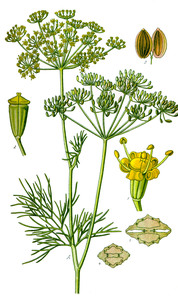
|
Anethum graveolens |
2-11
Full sun
Moist
Light (sandy), Medium
0.8
Annual
Herbs
Medium
15cm x 30cm
Essential Oil, Pest control, Fragrance
true
Leaves, Seed
Condiment, Tea
Dill
Apiaceae or umbelliferae
Algeria, Chad, Cyprus, Gulf States, Iran, Lebanon-Syria, Libya, Morocco, Oman, Saudi Arabia, Tunisia
Afghanistan, Alabama, Albania, Alberta, Altay, Andaman Is., Angola, Argentina Northeast, Arizona, Arkansas, Assam, Austria, Azores, Bahamas, Baleares, Baltic States, Bangladesh, Belarus, Belgium, Brazil South, Brazil Southeast, British Columbia, Bulgaria, California, Cameroon, Canary Is., Cape Verde, Cayman Is., Central European Rus, China North-Central, China South-Central, China Southeast, Connecticut, Costa Rica, Cuba, Czechoslovakia, Delaware, Denmark, Dominican Republic, East Aegean Is., East European Russia, East Himalaya, Ecuador, Eritrea, Ethiopia, Finland, France, Ghana, Great Britain, Greece, Guatemala, Haiti, Hawaii, Hungary, Illinois, India, Indiana, Iowa, Iraq, Italy, Jamaica, Kansas, Kazakhstan, Kentucky, Kenya, Kriti, Krym, Laos, Leeward Is., Louisiana, Madeira, Maine, Manitoba, Maryland, Massachusetts, Michigan, Minnesota, Missouri, Mongolia, Montana, Mozambique, Nebraska, Nepal, Netherlands, New Jersey, New York, Nicobar Is., Niger, Nigeria, North Carolina, North Dakota, Northwest European R, Norway, Ohio, Oklahoma, Ontario, Oregon, Pakistan, Palestine, Pennsylvania, Peru, Portugal, Primorye, Puerto Rico, Québec, Rhode I., Romania, Saskatchewan, Sicilia, Somalia, South Dakota, South European Russi, Spain, Sudan, Sweden, Switzerland, Tadzhikistan, Tanzania, Texas, Thailand, Transcaucasus, Trinidad-Tobago, Turkey, Turkey-in-Europe, Ukraine, Uzbekistan, Vietnam, Virginia, Wake I., Washington, West Virginia, Windward Is., Wisconsin, Yugoslavia
https://en.wikipedia.org/wiki/Dill
https://pfaf.org/User/Plant.aspx?LatinName=Anethum graveolens
https://powo.science.kew.org/taxon/urn:lsid:ipni.org:names:837530-1
Dill
|
Dill (Anethum graveolens) is a plant native to the eastern Mediterranean region and West Asia. It is an annual herb that grows to a height of about 1-2 feet and has delicate, feathery leaves. The plant has small yellow flowers that bloom in the summer. Dill is a popular herb in many cuisines, especially in European and Middle Eastern dishes. It is used to flavor soups, stews, fish, and pickles. The leaves and seeds of dill are both edible and can be used fresh or dried. The seeds have a more pungent flavor than the leaves and are often used in pickling. Dill can be stored by drying or freezing the leaves and seeds. Dill prefers full sun and well-drained soil. It is easy to grow and can be started from seed or from transplants. Dill is not winter hardy and will die off in the winter. In addition to its culinary uses, dill has been used medicinally to aid in digestion and to reduce inflammation. It has also been used as a natural insect repellent. The plant is attractive to many types of beneficial insects, making it a valuable addition to any garden. |
Show
Edit |
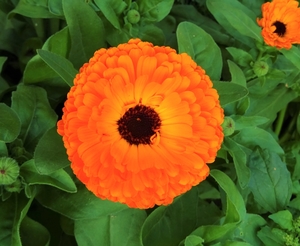
|
Pot marigold |
2-11
Full sun, Partial sun/shade
Moist
Light (sandy), Medium, Heavy (clay)
5.5-7.0
0.6
0.3
Annual
Medium
15cm
6-14 days
21°c (70°f)
60
Compost, Cosmetic, Dye, Essential Oil, Weather forecasting, Dynamic accumulator, Fragrance
Flowers, Leaves
Calendula, Common marigold, Scotch marigold, Ruddles
Ringelblume
Asteraceae or compositae
Spain
Afghanistan, Albania, Argentina Northeast, Argentina Northwest, Argentina South, Assam, Austria, Azores, Baleares, Baltic States, Belarus, Belgium, Bolivia, Borneo, British Columbia, Bulgaria, California, Canary Is., Central European Rus, Chatham Is., Chile Central, Chile North, Chile South, China North-Central, China South-Central, China Southeast, Colombia, Connecticut, Cook Is., Corse, Costa Rica, Cyprus, Czechoslovakia, East Aegean Is., East European Russia, East Himalaya, Ecuador, Ethiopia, France, Germany, Great Britain, Greece, Guatemala, Hainan, Honduras, Hungary, India, Iraq, Ireland, Italy, Jawa, Juan Fernández Is., Kazakhstan, Kriti, Krym, Lebanon-Syria, Lesser Sunda Is., Libya, Madeira, Maine, Malaya, Manchuria, Massachusetts, Mauritius, Mexico Southeast, Michigan, Morocco, Myanmar, Nepal, Netherlands, New Hampshire, New South Wales, New York, New Zealand North, New Zealand South, Newfoundland, North Caucasus, North European Russi, Northern Territory, Northwest European R, Norway, Nova Scotia, Ohio, Ontario, Pakistan, Paraguay, Pennsylvania, Peru, Philippines, Poland, Portugal, Primorye, Qinghai, Queensland, Québec, Romania, Sardegna, Sicilia, South Australia, South European Russi, Sulawesi, Sumatera, Sweden, Switzerland, Tadzhikistan, Taiwan, Tasmania, Tibet, Transcaucasus, Trinidad-Tobago, Turkey, Turkmenistan, Ukraine, Uruguay, Uzbekistan, Victoria, Vietnam, Washington, Western Australia, Wisconsin, Xinjiang, Yugoslavia
https://en.wikipedia.org/wiki/Calendula_officinalis
https://pfaf.org/User/Plant.aspx?LatinName=Calendula officinalis
https://powo.science.kew.org/taxon/urn:lsid:ipni.org:names:187894-1
4.6
Colouring, Tea
true
|
The pot marigold, also known as Calendula officinalis, is a flowering plant probably native to southwestern Asia, western Europe, and the Mediterranean region, however, its long cultivation history makes its precise origin unknown. It is a herbaceous annual plant that typically grows to be about 12-18 inches tall, with hairy stems and leaves. The leaves are lance-shaped, with a hairy surface, and the flowers can range in colour from white through yellow and orange to red and even pink. In terms of growing conditions, the pot marigold prefers well-drained soil and full sun, although it can tolerate partial shade. It is winter hardy, but may not flower as profusely in colder climates. To cultivate it successfully, a grower should plant pot marigold seeds directly in the ground after the last frost of the season. The pot marigold has a number of uses, both culinary and medicinal. The flowers are edible and can be used to add color and flavor to salads and other dishes. The petals can also be dried and used to make tea. In terms of medicinal uses, the plant has been used for centuries to treat a variety of ailments, including wounds, infections, and skin irritation. The pot marigold is also attractive to a variety of pollinators, making it a valuable plant for attracting beneficial insects to the garden. Overall, the pot marigold is a versatile and easy-to-grow plant that is well-suited to a variety of garden settings. ### Propagation - Direct sow Direct sow in spring when light frost is still possible. Can be sown until early summer for fall blooms. ### Propagation - Transplant Sow indoors in late winter, transplant outside when risk of heavy frost has passed. #### Links [Calendula @ West Coast Seeds](https://www.westcoastseeds.com/products/zeolights-organic) |
Show
Edit |
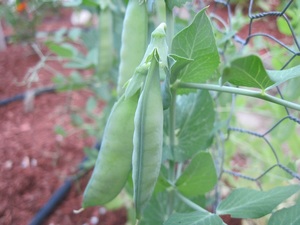
|
Pea |
3-9
Annual
Full sun
Moist
Light (sandy), Medium
2.0
Vines
Nitrogen fixer
true
Leaves, Seed, Shoots
https://en.wikipedia.org/wiki/Pea
Fabaceae or leguminosae
Erbse
https://pfaf.org/User/Plant.aspx?LatinName=Pisum sativum
Afghanistan, Albania, Algeria, Bulgaria, Corse, Cyprus, Egypt, France, Greece, Iran, Iraq, Italy, Krym, Lebanon-Syria, Libya, Morocco, North Caucasus, Palestine, Portugal, Romania, Sardegna, Sicilia, Spain, Transcaucasus, Tunisia, Turkey, Turkey-in-Europe, Turkmenistan, Ukraine, Yugoslavia
Alabama, Altay, Amur, Andaman Is., Assam, Austria, Baltic States, Bangladesh, Belarus, Belgium, Buryatiya, California, Canary Is., Cayman Is., Central European Rus, China North-Central, China South-Central, Chita, Colombia, Costa Rica, Cuba, Czechoslovakia, Dominican Republic, East Aegean Is., East European Russia, East Himalaya, Ethiopia, Fiji, Haiti, Idaho, Illinois, India, Irkutsk, Kamchatka, Kazakhstan, Kenya, Khabarovsk, Kirgizstan, Korea, Krasnoyarsk, Laos, Madeira, Magadan, Marianas, Maryland, Mexico Southwest, Mongolia, Mozambique, Myanmar, Nepal, New Guinea, New South Wales, New York, New Zealand North, New Zealand South, Nigeria, North European Russi, Northwest European R, Oregon, Pakistan, Primorye, Puerto Rico, Rwanda, Sakhalin, South Australia, South European Russi, South Georgia, Sri Lanka, Tadzhikistan, Tibet, Trinidad-Tobago, Tuva, Uganda, Uzbekistan, Vermont, Vietnam, Washington, West Himalaya, West Siberia, Yakutskiya, Yemen
Lathyrus oleraceus
https://powo.science.kew.org/taxon/urn:lsid:ipni.org:names:501912-1
3-5 years
0.3
https://powo.science.kew.org/taxon/urn:lsid:ipni.org:names:60454055-2
|
Peas are a type of legume, native to western Asia and the Near East. They are an annual plant, meaning they grow, flower, and produce seeds within a single growing season. Peas have tendrils that allow them to climb, and their leaves are typically made up of two oblong leaflets and a tendril on a single petiole. Peas produce clusters of small, fragrant flowers that can be white, pink, or purple in color. The flowers give way to pod-like fruits that contain the peas. Peas are a cool-season crop, and prefer to grow in well-drained soil that is high in organic matter. They can tolerate some shade, but will produce the best yields when grown in full sun. Peas can be differentiated from similar plants by their tendrils and the clusters of small, fragrant flowers that they produce. Peas are a relatively small plant, typically growing to a height of one to two feet. They can be grown in rows or as a companion plant, and will typically take between 60 and 90 days to reach maturity. Peas are not winter hardy, and should be planted in the spring as soon as the soil can be worked. Peas are edible, and the seeds inside the pods can be eaten fresh or dried for storage. The leaves and stems of the pea plant can also be eaten, and are a good source of vitamins and minerals. Peas can be used in a variety of dishes, and are a common ingredient in soups, stews, and casseroles. In addition to their culinary uses, peas are also valued for their ability to fix nitrogen in the soil. This makes them a valuable crop for improving soil fertility, and they are often grown as a cover crop or rotated with other crops to improve the overall health of the soil. Peas are also valued by wildlife, and their flowers and seeds are a favorite food for birds and other animals. |
Show
Edit |

|
Raphanus sativus |
2-11
Full sun, Partial sun/shade
Moist
Light (sandy), Medium, Heavy (clay)
0.5
0.3
Annual
Roots
Fast
true
Flowers, Leaves, Root, Seed, Seedpod
Oil
Cultivated radish
Rettich
Brassicaceae or cruciferae
Greece, Italy, Sicilia, Yugoslavia
Alabama, Alaska, Algeria, Altay, Andaman Is., Angola, Argentina Northeast, Argentina Northwest, Argentina South, Arizona, Arkansas, Assam, Baleares, Baltic States, Bangladesh, Belarus, Belgium, Bermuda, Bolivia, Brazil South, Brazil Southeast, British Columbia, Bulgaria, California, Canary Is., Caroline Is., Central European Rus, Chile Central, Chile North, Chile South, China North-Central, China South-Central, China Southeast, Colombia, Colorado, Connecticut, Corse, Costa Rica, Cuba, Cyprus, Delaware, District of Columbia, Dominican Republic, East Aegean Is., East European Russia, East Himalaya, Ecuador, Egypt, El Salvador, Eritrea, Ethiopia, Fiji, Florida, Galápagos, Georgia, Gilbert Is., Guatemala, Gulf of Guinea Is., Gulf States, Hainan, Haiti, Hawaii, Idaho, Illinois, India, Indiana, Inner Mongolia, Iowa, Iraq, Japan, Jawa, Kansas, Kazakhstan, Kazan-retto, Kenya, Korea, Kriti, Krym, Kuwait, Labrador, Lebanon-Syria, Leeward Is., Libya, Louisiana, Madeira, Maine, Manchuria, Manitoba, Marianas, Marshall Is., Maryland, Massachusetts, Mauritania, Mexican Pacific Is., Mexico Northwest, Michigan, Minnesota, Mississippi, Missouri, Montana, Morocco, Nansei-shoto, Nebraska, Nepal, Nevada, New Brunswick, New Caledonia, New Hampshire, New Jersey, New Mexico, New South Wales, New York, Newfoundland, Nicobar Is., North Carolina, North Dakota, North European Russi, Northern Provinces, Nova Scotia, Ohio, Oklahoma, Oman, Ontario, Oregon, Pakistan, Palestine, Paraguay, Pennsylvania, Portugal, Primorye, Prince Edward I., Puerto Rico, Qinghai, Queensland, Québec, Rhode I., Rwanda, Sardegna, Saskatchewan, Saudi Arabia, South Australia, South Carolina, South Dakota, South European Russi, Spain, Sri Lanka, Sudan, Sumatera, Switzerland, Tadzhikistan, Tanzania, Tasmania, Texas, Tibet, Tunisia, Turkey, Turkey-in-Europe, Turkmenistan, Ukraine, Uruguay, Utah, Uzbekistan, Victoria, Vietnam, Virginia, Wake I., Washington, West Himalaya, West Virginia, Western Australia, Windward Is., Wisconsin, Wyoming, Xinjiang, Yemen, Zimbabwe
https://en.wikipedia.org/wiki/Radish
https://pfaf.org/User/Plant.aspx?LatinName=Raphanus sativus
https://powo.science.kew.org/taxon/urn:lsid:ipni.org:names:77159305-1
Weed potential
Animal feed, Cover crop, oil
|
The radish, also known as Raphanus sativus, is a plant native to southwestern Asia and the eastern Mediterranean region. It is a cool-season annual that grows quickly, often maturing in just a few weeks. The radish has a distinctive round or oblong shape, with a crisp and juicy texture. Its skin is typically red or white, but can also be purple, yellow, or black. The leaves of the radish are elongated and dark green in color, while its flowers are small and white or yellow in color. Radishes are relatively small, typically growing to be about four inches long and two inches wide. They prefer well-drained soil that is high in organic matter, and can be grown in a variety of climates, including temperate and subtropical regions. Radishes are typically differentiated from similar plants, such as turnips, by their smaller size and more pungent flavor. They can be harvested at any stage of their growth, but are typically harvested when they are young and tender for the best flavor. To cultivate radishes successfully, a grower will need to plant them in well-prepared soil, water them regularly, and thin out the plants to prevent overcrowding. Radishes are generally hardy and can tolerate frost, making them a good choice for a fall or winter garden. The edible parts of the radish plant are the root and the leaves. The root can be eaten raw, cooked, or pickled, while the leaves can be used in salads or cooked like other leafy greens. After harvest, the roots can be stored in a cool and dark place, such as a root cellar, to prolong their shelf life. Radishes have a number of uses, both in the garden and beyond. In the garden, they can be used as a companion plant to deter pests and improve the health of other plants. In addition to their use in cooking, radishes have also been used medicinally, with some evidence suggesting that they may have anti-inflammatory and digestive health benefits. Radishes are also a valuable food source for wildlife, providing a source of nutrition for birds and small mammals. They are a popular food for bees and other pollinators, and can help to attract these beneficial insects to the garden. |
Show
Edit |
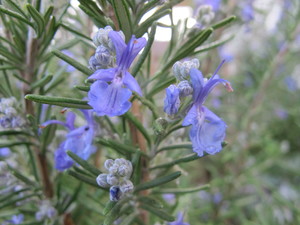
|
Rosemary |
6-11
Perennial
Full sun
Dry, Moist
Light (sandy), Medium
Evergreen
1.5
Herbs
Attracts insects, Hedgerow
true
Leaves
https://en.wikipedia.org/wiki/Rosemary
Medium
Lamiaceae or labiatae
true
Rosmarinus officinale, rosmarinus officinalis
https://pfaf.org/User/Plant.aspx?LatinName=Rosmarinus officinalis
Albania, Algeria, Baleares, Corse, Cyprus, East Aegean Is., Egypt, France, Greece, Italy, Libya, Morocco, Portugal, Sardegna, Sicilia, Spain, Tunisia, Turkey, Yugoslavia
Azores, Bermuda, Bulgaria, Canary Is., Cape Verde, Germany, Great Britain, Kriti, Krym, Madeira, Mexico Central, Mexico Southwest, Texas, Trinidad-Tobago
1.2
https://powo.science.kew.org/taxon/urn:lsid:ipni.org:names:457138-1
|
Rosemary (Salvia rosmarinus) is a woody, perennial herb native to the Mediterranean region. It is an evergreen shrub that grows to a height of 1-2 meters and has narrow, linear leaves that are about 2-4 cm long and 1-2 mm wide. The leaves are dark green in color and have a strong, pungent aroma. The flowers of rosemary are blue, purple, or white in color and grow in clusters on the tips of the branches. Rosemary prefers well-drained soil and full sun, and it grows best in temperate climates. It can be grown in a variety of soil types, including sandy and loamy soils, but it does not tolerate wet or waterlogged conditions. To cultivate rosemary successfully, the plant should be watered regularly during the growing season and pruned regularly to maintain its shape. Rosemary's leaves are edible and can be used as a seasoning in a variety of dishes. The leaves can be dried and stored for later use, or they can be used fresh. They can also be used to make tea. Rosemary has a number of uses, including as a medicinal herb and as a source of essential oils. It has been used to treat a variety of ailments, including indigestion, headaches, and muscle pain. It has also been used to improve memory and cognitive function. In addition, rosemary has been used as a fertility aid and to improve circulation. Rosemary is not particularly valuable as a food source for wildlife, but it can provide shelter and habitat for a variety of animals. It is often used as a decorative plant in gardens and landscaping. |
Show
Edit |

|
Sage |
3-11
Annual, Perennial
Full sun
Dry, Moist
Light (sandy), Medium
Evergreen
0.6
Herbs
Flowers, Leaves
https://en.wikipedia.org/wiki/Salvia_officinalis
Medium
Kitchen sage, Small Leaf Sage, Garden Sage, Adacayi, Broadleaf sage, Ching-chieh, Common sage, Echter salbei, Mariyamiya, Sa er wei ya, Salbei, Salie, Salva, Salvia, Sauge commune, Sauge officinale, Sauge, Shalfey, True sage
Lamiaceae or Labiatae
Salbei
https://pfaf.org/User/Plant.aspx?LatinName=Salvia officinalis
Albania, France, Germany, Greece, Italy, Spain, Switzerland, Yugoslavia
Alabama, Algeria, Austria, Azores, Baleares, Bulgaria, California, Canary Is., Connecticut, Czechoslovakia, Georgia, Idaho, Kentucky, Korea, Libya, Maine, Maryland, Michigan, Morocco, New York, Ohio, Ontario, Oregon, Pennsylvania, Portugal, Québec, Rhode I., Romania, Sardegna, Sicilia, South European Russi, Tennessee, Transcaucasus, Tunisia, Turkey-in-Europe, Ukraine, Uruguay, Utah, Vermont, Virginia, Washington, West Virginia
0.75
https://powo.science.kew.org/taxon/urn:lsid:ipni.org:names:456833-1
Condiment, Tea
Compost, Essential Oil, Strewing, Teeth, Dynamic accumulator, Ground cover, Fragrance
true
|
Sage is a perennial herb native to the Mediterranean region. It has woody stems with gray-green leaves that are typically 2-4 inches long and have a soft, velvety texture. The flowers of sage are small and typically blue or purple, although they can also be white or pink. Sage grows to a height of about 2-3 feet and has a spreading habit. Sage prefers well-drained, sandy soil and full sun, and is drought-tolerant once established. It is winter hardy in most climates, but may need to be protected in very cold regions. To cultivate sage successfully, it is important to prune the plant regularly to promote new growth and prevent the plant from becoming woody. The leaves of sage are edible and have a strong, savory flavor. They can be used fresh or dried and are often used in dishes such as stuffings, sausages, and marinades. The leaves can also be stored for later use by drying them and storing them in an airtight container. Sage has a number of uses beyond its culinary value. It has traditionally been used for its medicinal properties, and is said to have antibacterial and anti-inflammatory effects. It is also often used as a fertility herb and is said to promote lactation in nursing mothers. Sage can also be used as a natural insect repellent and as a mulch to suppress weeds. Sage is valued by wildlife for its nectar, which attracts bees and other pollinators. It is also an important host plant for the larvae of several species of butterflies and moths. In addition, the leaves of sage can be used as a natural insecticide to control aphids and other garden pests. In humid zones above 9 it might be only possible to grow as an annual. |
Show
Edit |

|
Garlic |
3-10
Perennial
Full sun
Dry, Moist
Light (sandy), Medium
0.6
Herbs
Flowers, Leaves, Root, Seed
Seed - direct sow
https://en.wikipedia.org/wiki/Garlic
Cultivated garlic
Alliaceae
Knoblauch
20cm
https://pfaf.org/User/Plant.aspx?LatinName=Allium sativum
6.5-7.0
Sting and itch relief from insect bites
Fibrous
Shallow
100-150
Allium
Iran, Kazakhstan, Kirgizstan, Tadzhikistan, Turkmenistan, Uzbekistan
Albania, Algeria, Amur, Austria, Baleares, Baltic States, Bangladesh, Belarus, Bulgaria, Cambodia, Canary Is., Central European Rus, China North-Central, China South-Central, China Southeast, Corse, Cuba, Czechoslovakia, Dominican Republic, East European Russia, Egypt, Ethiopia, France, Galápagos, Germany, Greece, Haiti, Hungary, Illinois, India, Iraq, Italy, Jamaica, Kentucky, Korea, Leeward Is., Libya, Mexico Central, Mexico Northwest, Mexico Southeast, Mexico Southwest, Morocco, New York, North European Russi, Northwest European R, Pakistan, Poland, Primorye, Puerto Rico, Romania, Sardegna, Seychelles, Sicilia, South European Russi, Spain, Switzerland, Tennessee, Thailand, Trinidad-Tobago, Tunisia, Turkey, Ukraine, Vermont, Wisconsin, Yugoslavia
Late autumn, Early spring
https://powo.science.kew.org/taxon/urn:lsid:ipni.org:names:528796-1
Adhesive, antifungal, Dynamic accumulator
true
|
Garlic (Allium sativum) is a bulbous perennial plant in the family Amaryllidaceae. It is native to central Asia and northeastern Iran, and has long been a staple in cuisines around the world. The plant has a distinctive appearance, with narrow, long leaves and a tall, hollow stem. The leaves are a pale green color and are attached to the stem in a spiral arrangement. The flowers are small and white, and are clustered in a spherical head at the top of the stem. Garlic plants can grow to a height of 30-150 cm (12-59 in), depending on the variety. They are relatively fast-growing plants, with the bulbs maturing in about seven months. Mulch for proper overwintering when planted in autumn. Garlic can be differentiated from other plants in the Allium genus by its distinctive flavor and aroma. It is also often distinguished by its long, narrow leaves and tall, hollow stem. Garlic prefers well-drained soil and full sun, and is typically grown from bulbs. To cultivate garlic successfully, growers should plant the bulbs in the fall, about 6-8 weeks before the first frost. The bulbs should be spaced about 10-15 cm (4-6 in) apart, with the pointed end facing up. After planting, the bulbs should be watered regularly and mulched to protect them from cold temperatures. Garlic is edible, with the bulbs and leaves being the most commonly eaten parts of the plant. The bulbs can be used fresh or cooked, and are often used as a seasoning in a wide variety of dishes. The leaves can be used fresh or cooked, and have a milder flavor than the bulbs. To harvest dig and do not pull out the bulbs. Let them dry in an airy, shady and dry spot e.g. by hanging them up. Once wrappers are dry, it can be stored at a dry place for several months. In addition to its culinary uses, garlic has a number of other uses. It is commonly used medicinally, as it has been shown to have antimicrobial and anti-inflammatory properties. It is also sometimes used as a natural insect repellent. In the garden, it can be used as a natural fertilizer, as it is believed to improve the soil and help deter pests. Garlic has value for wildlife, as it is attractive to a wide variety of pollinators, including bees, butterflies, and hummingbirds. It is also a food source for animals such as rabbits and deer. |
Show
Edit |

|
Runner Bean |
1-12
Annual, Perennial
Full sun
Moist
Light (sandy), Medium, Heavy (clay)
3.0
true
Flowers, Leaves, Root, Seed, Seedpod
https://en.wikipedia.org/wiki/Phaseolus_coccineus
Fast
Scarlet runner, scarlet runner bean, scarlet conqueror, fire bean, mammoth, red giant phaseolus coccineus ssppolyanthus (cache bean)
Fabaceae or leguminosae
https://pfaf.org/User/Plant.aspx?LatinName=Phaseolus coccineus
Guatemala, Honduras, Mexico Central, Mexico Gulf, Mexico Northeast, Mexico Northwest, Mexico Southeast, Mexico Southwest, Nicaragua, Panamá
Alabama, Amur, Assam, Baltic States, Bangladesh, Belarus, Bulgaria, Central European Rus, China North-Central, China South-Central, China Southeast, Colombia, Czechoslovakia, East European Russia, East Himalaya, Ecuador, Ethiopia, India, Inner Mongolia, Jawa, Kenya, Khabarovsk, Kirgizstan, Korea, Manchuria, Nepal, New Guinea, New Zealand North, New Zealand South, North European Russi, Northwest European R, Pakistan, Primorye, Rwanda, South European Russi, Tanzania, Transcaucasus, Ukraine, Uzbekistan, Wake I., West Himalaya
3-5 years
https://powo.science.kew.org/taxon/urn:lsid:ipni.org:names:513754-1
Nitrogen fixer
|
Show
Edit |
|

|
Allium cepa ascalonicum |
4-8
Full sun
Moist
Light (sandy), Medium
5.0-7.0
0.3
0.2
Herbs
25cm, 10inch
Seed - direct sow
mid-Nov. - mid-March
Flowers, Leaves, Root
Alliaceae, Liliaceae
https://en.wikipedia.org/wiki/Shallot
https://pfaf.org/User/Plant.aspx?LatinName=Allium cepa ascalonicum
Cosmetic, Dye, Hair, Polish, Rust
true
|
Easy to grow vegetable that grow from a bulb. Edible parts are used for cooking. Exists in many varieties. Grows well in any fertile, well-drained soil at a sunny spot. Is started from seeds or sets (immature bulbs). Has a long growing period. |
Show
Edit |
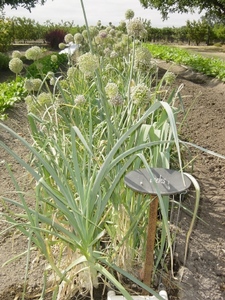
|
Allium porrum |
5-9
Full sun
Moist
Light (sandy), Medium
0.9
Herbs
Pest control, Repels carrot rust flies
Flowers, Leaves, Root
Seed - transplant
https://en.wikipedia.org/wiki/Leek
Garden leek
Alliaceae, Liliaceae
https://pfaf.org/User/Plant.aspx?LatinName=Allium porrum
sow indoors in containers from Feb., transplant early summer
15cm
Feb. - April
6.0-6.5
< 65°F
Albania, Algeria, Baleares, Bulgaria, Cyprus, East Aegean Is., Egypt, Ethiopia, France, Greece, Iran, Iraq, Italy, Kriti, Lebanon-Syria, Libya, Morocco, Palestine, Portugal, Romania, Sardegna, Sicilia, Sinai, Spain, Transcaucasus, Tunisia, Turkey, Turkey-in-Europe, Turkmenistan, Uzbekistan, Yugoslavia
Alabama, Argentina Northeast, Azores, Baltic States, Belarus, California, Canary Is., Central European Rus, Cuba, Czechoslovakia, Dominican Republic, East European Russia, Galápagos, Great Britain, Haiti, Illinois, Ireland, Kentucky, Madeira, Mexico Central, Mexico Northeast, Mexico Northwest, Mexico Southeast, Mexico Southwest, New South Wales, New York, North European Russi, Northwest European R, Pakistan, Puerto Rico, South Australia, South European Russi, Tasmania, Tennessee, Texas, Ukraine, Victoria, Western Australia
Allium ampeloprasum
https://powo.science.kew.org/taxon/urn:lsid:ipni.org:names:332079-2
May - July
0.15
https://powo.science.kew.org/taxon/urn:lsid:ipni.org:names:528646-1
true
|
The leek is a member of the onion family. It is native to the eastern Mediterranean and parts of Asia. The plant has long, flat, glossy leaves that are typically green in color. It has a white stem that widens into a bulb at the bottom. The plant has a distinctive, onion-like aroma and flavor. Leek plants grow to a height of around one to two feet and have a spread of six to eight inches. They grow relatively slowly, taking around three to four months to reach maturity. Leeks can be distinguished from other members of the onion family by their larger size and more elongated shape. Leek plants prefer moist, well-drained soil and full sun. They can be grown in a variety of soil types but prefer a slightly alkaline pH. To cultivate leeks successfully, a grower should plant them in trenches or hills and keep the soil moist throughout the growing season. Leeks are winter hardy and can be grown in most climates. Usually sown in containers or seed beds first and then moved to their final place a few months later. Leeks are edible and can be used in a variety of dishes. The edible parts of the plant are the white stem and the tender inner leaves. Leeks can be stored in the refrigerator for several weeks after harvest. In addition to their use in cooking, leeks have a number of other uses. They can be used medicinally to treat a variety of conditions, including coughs and respiratory problems. |
Show
Edit |
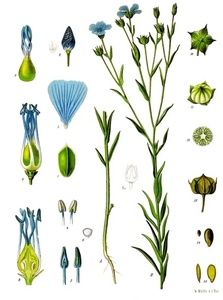
|
Flax |
4-8
Annual
Full sun
Moist
Light (sandy), Medium
0.7
true
Seed
https://en.wikipedia.org/wiki/Flax
Common flax
Linaceae
Sommerlein, lein
Oil, Coffee, Gum
https://pfaf.org/User/Plant.aspx?LatinName=Linum usitatissimum
6
Manitoba, Turkey
Iran, Kazakhstan, Kirgizstan, North Caucasus, Tadzhikistan
https://powo.science.kew.org/taxon/urn:lsid:ipni.org:names:267411-1
Biomass, Fiber, Gum, textiles, oil, Dynamic accumulator
|
Flax, also known as Linum usitatissimum, is a plant native to the Mediterranean region. It is a slender annual plant that grows to about 1-2 feet tall and has slender, branching stems. The leaves are narrow and lanceolate, and the flowers are small and pale blue. Flax is a fast-growing plant that prefers well-drained, moist soil and full sun. It is not winter hardy and should be planted in the spring. To cultivate flax successfully, a grower should keep the soil moist and weed-free, and provide the plant with plenty of sunlight. Flax is not typically grown for its edible parts, but the seeds can be ground into a meal or flour and used in baking. The plant's fibers, on the other hand, are used to make linen fabric. To harvest the fibers, the stems are soaked in water to loosen the fibers, which are then pulled out by hand or with a tool. Flax has been used for centuries for its fibers, which are strong and durable. In addition to making fabric, flax fibers can also be used for weaving, building material, and other purposes. Flax is also valued for its medicinal properties and has been used to treat a variety of ailments. It is also a good source of nectar for bees and other pollinators. |
Show
Edit |